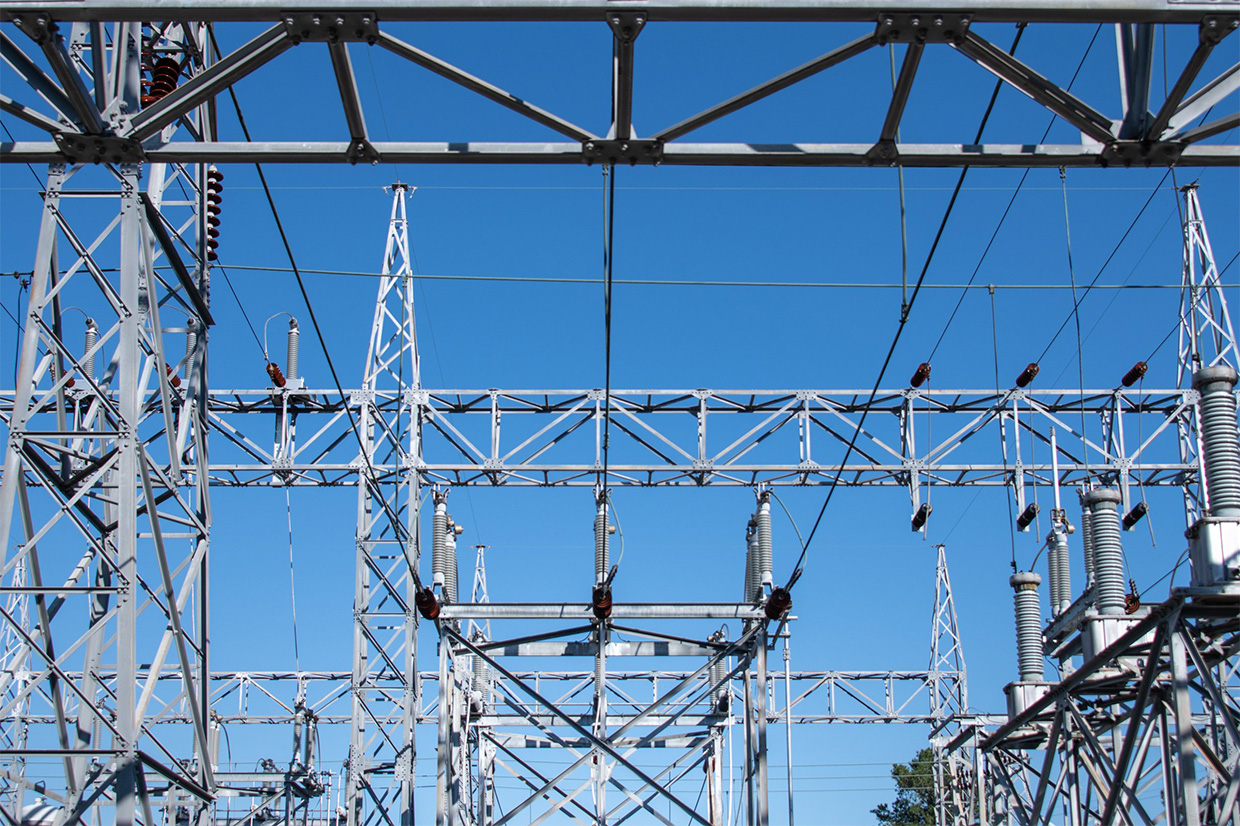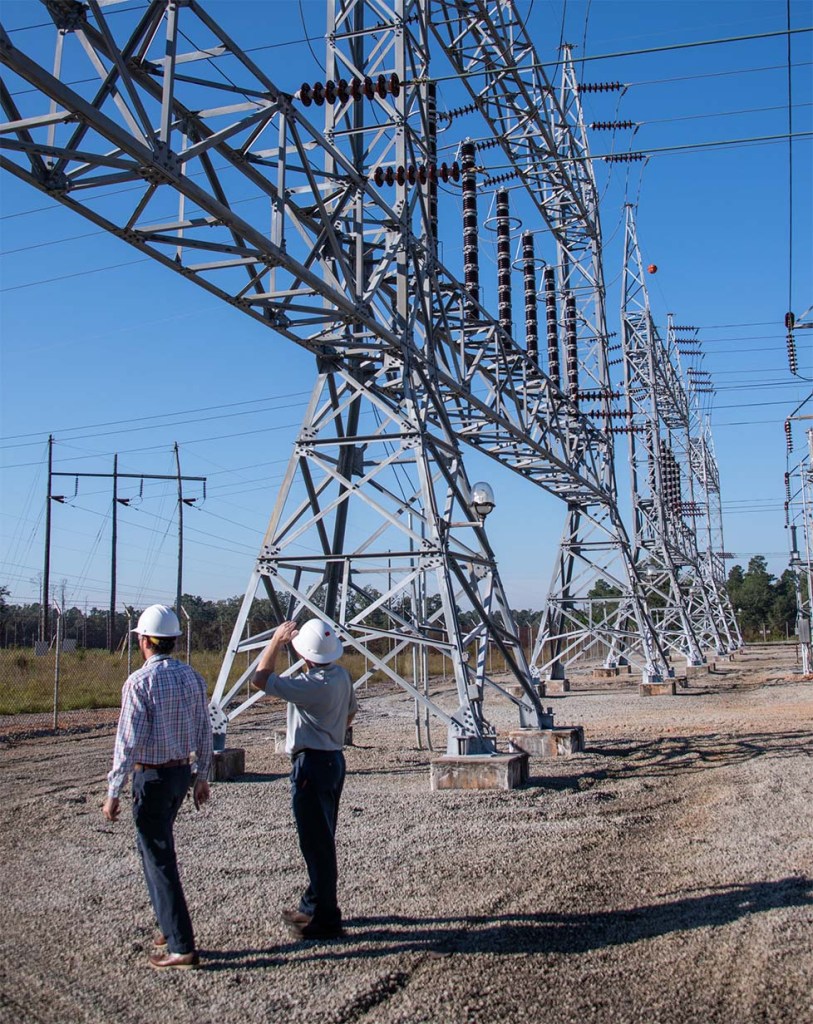“When someone switches on the light-switch, the light turns on, and they are afforded the ability to never question whether or not the light will in fact turn on.” – Glenn Fink

SRNL substation on the Savannah River Site (SRNS Photo)
How SRNL’s Legacy Helps Ensure Grid Security
Our world is becoming increasingly interconnected and, now more than ever, the security of our power grid is paramount. As we become more interconnected the emergence of cyber threats is also a growing concern. Savannah River National Laboratory’s Global Security Directorate supports the U.S. national security communities by focusing efforts on power grid security, electronic warfare and wireless test and evaluation processes.
Energy security, according to The Department of Energy’s Office of Energy Efficiency and Renewable Energy, is having enough energy to meet demand and having a power system and infrastructure that are protected against physical and cyber threats.
However, according to SRNL’s Director of Cyber Security Strategy, Glenn Fink, it is as simple as, “When someone switches on the light-switch, the light turns on, and they are afforded the ability to never question whether or not the light will in fact turn on.”
Ensuring that everyone’s lights remain on is achieved through safeguarding both critical cyber and physical infrastructure. SRNL supports that safeguarding effort through extensive and innovative testing.
Unique Testing Ground
In the 1950s Savannah River Site was home to five nuclear reactors that produced the fissile materials used in nuclear weapons. All of the reactors were shut down by 1989, which now makes those areas usable to help protect our grid’s future.
SRS had a vast electrical network that serviced nuclear reactors and related facilities. With the reactors no longer running, there are 17 miles of transmission line that are surplus to the site’s needs. SRNL is partnering with Federal and South Carolina State departments and agencies, SRS stakeholders, industry and other national labs to refurbish those transmission lines to form a testbed for voltages from 115kV to 230kV. This testbed is substantially isolated from the remainder of SRS’s transmission lines and the surrounding commercial power grid.
SRNL’s testbed will allow grid components to be tested in a complex integrated system to better understand how they interact and may negatively affect each other. Power companies are conservative in adopting new technology because their only place to test interactions is on the actual power grid where failure of the new technology can negatively affect consumers, and data collection could harm consumer privacy. SRNL’s testbed will enable grid operators and equipment manufacturers to test and gain confidence in a low-risk environment.
Another initiative that SRNL is working on is Threat Hunting Representations for Embedded Anomaly Tracking. THREAT helps cyber threat hunters understand data within their systems. This means that SRNL is developing the ability to help power companies learn what to look for when analyzing computer communication to determine what normal communication flows look like. Fink says that this is key for power companies because, while they ensure that the physical grid is ready and resilient, they may not have the bandwidth to recognize and analyze future threats.
Beyond prevention, SRNL also focuses on enhancing grid resilience. Examining cyber electromagnetic issues gives SRNL a better understanding of the potential threats and how to mitigate them. Introducing new equipment, such as transformers, to the grid prematurely can lead to potential blackouts, but the test bed allows new equipment to be tested on a self-contained grid to mitigate risk.
SRNL also has simulators, which include control modules from real equipment, that are used for training and helping power plants with their resiliency efforts. These simulations allow groups like the National Nuclear Security Administration, the Department of Defense and other agencies to learn how to defend the electrical grid from cyber attackers.

SRNL power substation. (SRNS Photo)
Looking to the Future
“One of our main roles as a national lab is to think ahead two-to-five-years and find out how we’re going to meet challenges that we expect to have before they become really popular,” says Fink. To help achieve this, his group is working on a solution using Artificial Intelligence.
One project Fink’s group is working on in collaboration with our partners, uses technology to help align safety, safeguards and security information from small modular nuclear reactors using AI to try to enhance security for the nation.
When it comes to cyber security, network engineers who have sizable networks rarely know everything that’s on it. Fink’s goal with AI is to characterize what is normal on networks where there are some unknown components. He wants to use these characterizations to help operators understand when their network deviates from normal status and what those deviations mean.
Grid security is a collaborative effort, and SRNL actively engages in partnerships with government agencies, energy providers, industry and sibling DOE National Laboratories to share knowledge to coordinate an approach to grid vulnerabilities and how to counteract them.
While protecting the grid is a multifaceted, ever evolving task, SRNL has a stake in preparing the world for future threats to come. From nuclear reactors of the past to our 17 miles of disconnected transmission line, SRNL’s unique role in ensuring grid security allows us to leverage the infrastructure of the past to create the grid of the future.